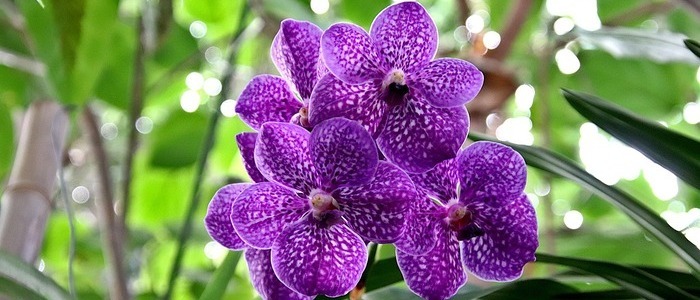Tending to the purple basil plant does not have to be an arduous task. By following these helpful tips, readers can keep their herb garden lush and vibrant.
Organic matter can provide essential nutrition for optimal health; adding compost or manure every two to three weeks is recommended. Mulch should also be applied around the base of the plant to maintain moisture levels in hotter climates.
Four to six hours of direct sunlight is necessary for producing flavorful leaves. For particularly warm weather, partial shade should be provided during peak hours of heat. The herb should then be watered frequently but not excessively as too much water may lead to root rot and other issues for the plant.
Regular pruning will keep growth in check while allowing new buds along cut stems, which produces more flavor-filled leaves for harvesting later on. When taking off the top portion of stems, it is important that entire leaves are not snipped away at once; this will help with even distribution and allow tastier leaves to develop over time.
Through proper care and attention, anyone can have a beautiful garden full of fragrant herbs like purple basil growing within their own backyard!

Purple Basil Plant Frequently Asked Questions
How do I properly care for a purple basil plant?
To properly care for the purple basil plant, it is important to provide it with well-draining soil and ample sunlight. Water the plant regularly, ensuring that the soil remains moist but not waterlogged. You should also apply a layer of mulch around the base of the plant can help retain moisture and suppress weed growth. Pinching off the flowers as they appear will encourage the plant to put more energy into leaf production, resulting in a bushier and healthier purple basil plant.
Does purple basil like sun or shade?
Purple basil plants thrive in full sun, as they require at least 6 to 8 hours of direct sunlight per day. However, they can tolerate some shade, especially during the hottest hours of the day. It is important to strike a balance between providing enough sun for the plant to thrive and protecting it from scorching heat.
Tips for Growing and Caring for the Purple Basil Plant
For a successful and flavorful harvest, growing and caring for the purple basil plant (Ocimum basilicum) requires some effort. To ensure success, follow these tips:
Begin by preparing the soil with organic matter such as compost or manure. This will provide your plants with all the necessary nutrients they need to grow optimally. Give them plenty of sunlight – at least four to six hours of direct sunlight per day is ideal – and make sure they’re not overcrowded by other plants or trees; otherwise their growth could be stunted due to lack of adequate exposure.
When it comes to watering frequency, regularity is key. Keep them hydrated, but don’t overwater them! Additionally, fertilize every two to three weeks using an all-purpose fertilizer for extra nutrition. Furthermore, once your plants reach 8-10 inches tall trim them back in order to promote new growth and a full flavored harvest.
Finally, look out for potential issues like pests (aphids, whiteflies or spider mites) or diseases (powdery mildew or root rot). If any are present take action swiftly by using natural remedies before they spread to other nearby vegetation.
By following these guidelines you can enjoy sweet flavors and lovely hues in your own garden with the purple basil plant!
How to Propagate the Purple Basil Plant
Propagation is a great way to increase the number of purple basil plants in your garden and ensure you have an abundance of this flavorful herb for years to come. There are three main methods of propagation – stem cuttings, layering, and division – each with its own set of steps that need to be followed.
Stem Cuttings: For stem cuttings, select healthy stems from mature plants that have at least two sets of leaves. Cut the stem just beneath the nodes (the point where the leaf joins the stem) and dip it in rooting hormone before planting it into a pot filled with soil or vermiculite. Water gently, cover with plastic wrap to retain moisture, and place in indirect sunlight for several weeks until roots form. Once rooted, transplant them into their permanent location in your garden.
Layering: Layering is an easy way to propagate purple basil plants without having to wait for roots to form on cuttings. Choose stems from mature plants and bend them down towards the ground so that a section touches the soil. Secure it in place by covering it with soil or mulch, then water generously until established roots form (usually 6-8 weeks). Once rooted you can cut away from parent plant and transplant into permanent location in your garden.
Division: Division is another effective method of propagating purple basil plants as it encourages rapid growth due to more root space available for new shoots. Divide large clumps by hand or use a shovel or spade to loosen up soil around clump before lifting out entire plant. Gently separate out sections while
keeping as many roots attached as possible before replanting each divided portion into pots filled with soil or vermiculite and placing them in indirect sunlight until established roots form (usually 4-6 weeks). Once rooted they can be transplanted into their permanent locations in your garden.
By following these tips on how to propagate purple basil plants readers will be able to enjoy this unique and flavorful herb year after year! With proper care and attention these herbs will thrive in any garden setting providing delicious flavor for salads, sauces, teas – not mention medicinal benefits too!
Common Problems Found When Growing the Purple Basil Plant
This section of the article will cover common problems that can arise when growing the purple basil plant. Readers will learn how incorrect temperature, inadequate soil drainage, overwatering, too much shade, and insufficient feeding can all lead to issues such as wilting, root rot, blight, fungal diseases, mossy patches, poor growth and development.
Incorrect temperatures can cause purple basil plants to become stunted or wilt due to extreme heat or cold weather. If the temperature drops below 50°F (10°C), then it is possible for the plant to wilt and die. To avoid this issue, make sure that your purple basil plants are shielded from strong winds and placed in an area with a good air flow that is not exposed to direct sunlight during peak hours of the day.
Soil drainage is also an important factor when growing purple basil. The soil should be well-draining so that excess water does not stay around the roots for too long – this creates an environment in which root rot and fungal diseases can thrive. Additionally, make sure to only water your plant when necessary – overwatering can lead to wet feet which can further invite disease-causing organisms into your soil.
Too much shade is another common problem faced by those who grow purple basil – if left in a shaded area for too long it could result in a weaker flavor and/or less vibrant color in its leaves. Make sure that your plant receives four to six hours of direct sunlight each day in order to prevent this issue from occurring.
Finally, inadequate feeding can lead to stunted growth and a lack of vigor in the leaves of your purple basil plant. Fertilizing your plant every two weeks with organic matter or compost will ensure that it has enough nutrients available for healthy growth so it’s best practice to incorporate this into your regular care routine.
By being aware of these common problems associated with growing purple basil plants and taking steps to address them accordingly readers will be better equipped to get the most out of their herb gardens! With proper care and attention they’ll be able enjoy unique flavors year after year without any issues arising from poor management practices or environmental conditions outside their control.
Conclusion
The purple basil plant is a unique and flavorful herb that can add a sweet taste to salads, sauces, and other dishes. This blog post has provided an overview of the plant, tips on how to care for it, advice on how to propagate it, and common problems that may arise when growing it. With the right care and attention, readers can enjoy all the benefits of this herb in their own gardens.
In order to get the most out of growing the purple basil plant, readers should prepare the soil with organic matter, provide plenty of sunlight, water regularly but not excessively, prune once plants reach 8-10 inches tall, fertilize every two weeks and look out for potential pests and diseases. When propagating purple basil plants there are three main methods – stem cuttings, layering or division – which need to be followed closely in order to ensure successful growth. Finally, readers should be aware of common problems such as wilting or root rot that can arise when growing this unique herb.
Overall, by following these guidelines closely readers will be able to successfully grow their own purple basil plants and enjoy its unique flavor in their cooking for many years ahead! To keep up with the latest information about how to grow and care for this special herb we recommend following our social media accounts or subscribing to our newsletter.
Conclusion













